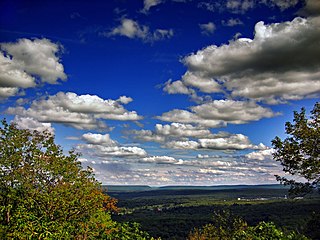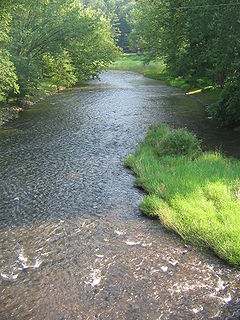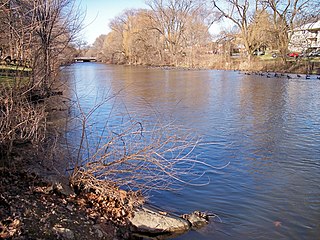
Tobyhanna Creek is a 29.9-mile-long (48.1 km) [1] tributary of the Lehigh River in the Pocono Mountains of eastern Pennsylvania in the United States. [2]

A tributary or affluent is a stream or river that flows into a larger stream or main stem river or a lake. A tributary does not flow directly into a sea or ocean. Tributaries and the main stem river drain the surrounding drainage basin of its surface water and groundwater, leading the water out into an ocean.

The Lehigh River, a tributary of the Delaware River, is a 109-mile-long (175 km) river located in eastern Pennsylvania, in the United States. Part of the Lehigh, along with a number of its tributaries, is designated a Pennsylvania Scenic River by the state's Department of Conservation and Natural Resources. "Lehigh" is an Anglicization of the Lenape name for the river, Lechewuekink, meaning "where there are forks".

The Pocono Mountains, commonly referred to as The Poconos, are a geographical, geological, and cultural region in Northeastern Pennsylvania, United States. The Poconos are an upland of the larger Allegheny Plateau. Forming a 2,400-square-mile (6,200 km2) escarpment overlooking the Delaware River and Delaware Water Gap to the east, the mountains are bordered on the north by Lake Wallenpaupack, on the west by the Wyoming Valley and the Coal Region, and to the south by the Lehigh Valley. The name comes from the Munsee word Pokawachne, which means "Creek Between Two Hills." Much of the Poconos region lies within the Greater New York-Newark, NY-NJ-CT-PA Combined Statistical Area. The wooded hills and valleys have long been a popular recreation area, accessible within a two-hour drive to millions of metropolitan area residents, with many communities having resort hotels with fishing, hunting, skiing, and other sports facilities.
Contents
The upper reaches of the creek pass through or near Tobyhanna Township, Tobyhanna Army Depot and Tobyhanna State Park. [2]
Tobyhanna Army Depot, is a logistics center for the United States Department of Defense (DoD), specializing in electronic systems and located in Coolbaugh Township, Monroe County, near Tobyhanna, Pennsylvania. Established February 1, 1953, as Tobyhanna Signal Depot, today it is a facility for the repair, upgrade and integration of Command, Control, Computer, Communications, Intelligence, Surveillance and Reconnaissance (C4ISR) systems for all branches of the Armed Forces.

Tobyhanna State Park is a Pennsylvania state park on 5,440 acres (2,201 ha) mostly in Coolbaugh Township, Monroe County, with a small portion of the park in Dreher and Lehigh townships in Wayne County, all in Pennsylvania in the United States. The park includes the 170-acre (69 ha) Tobyhanna Lake and a portion of Tobyhanna Creek. It is located 2.1 miles (3.4 km) north of the town of Tobyhanna, with the main park entrance on Pennsylvania Route 423, and a portion that borders on Pennsylvania Route 196. The park lies immediately adjacent to Gouldsboro State Park, Pennsylvania State Game Lands 312, and State Game Land 127.
Tunkhannock Creek joins Tobyhanna Creek near Blakeslee in Monroe County. [2]

Blakeslee is an unincorporated community in Tobyhanna Township in Monroe County, Pennsylvania, United States. Blakeslee is located at the intersection of Pennsylvania Route 115 and Pennsylvania Route 940.

Monroe County is a county in the U.S. state of Pennsylvania. As of the 2010 census, the population was 169,842. Its county seat is Stroudsburg. The county was formed from sections of Northampton and Pike counties. Named in honor of James Monroe, the fifth president of the United States, the county is located in northeastern Pennsylvania, along its border with New Jersey. Monroe County is coterminous with the East Stroudsburg, PA Metropolitan Statistical Area, within the Greater New York–Newark, NY–NJ–CT–PA Combined Statistical Area. It also borders the Lehigh Valley and has connections to the Delaware Valley, being a part of Philadelphia's Designated Media Market.
Tobyhanna Creek (Native American for "a stream whose banks are fringed with alder") joins the Lehigh River at the community of Stoddartsville, 6.1 miles (9.8 km) upstream of the Francis E. Walter Dam. [2]

Native Americans, also known as American Indians, Indigenous Americans and other terms, are the indigenous peoples of the United States, except Hawaii. There are over 500 federally recognized tribes within the US, about half of which are associated with Indian reservations. The term "American Indian" excludes Native Hawaiians and some Alaska Natives, while Native Americans are American Indians, plus Alaska Natives of all ethnicities. Native Hawaiians are not counted as Native Americans by the US Census, instead being included in the Census grouping of "Native Hawaiian and other Pacific Islander".

The Francis E. Walter Dam is an embankment dam located in Bear Creek Township, Luzerne County, Pennsylvania. Constructed in 1961 by the United States Army Corps of Engineers, it spans the Lehigh River at its confluence with the tributary Bear Creek, creating the Francis E. Walter Reservoir. Although the dam was originally constructed for flood management, its reservoir has since become a popular recreational area for fishing, kayaking, and boating. It was originally called Bear Creek Dam, but was renamed in 1963 after United States Congressman Francis E. Walter.










